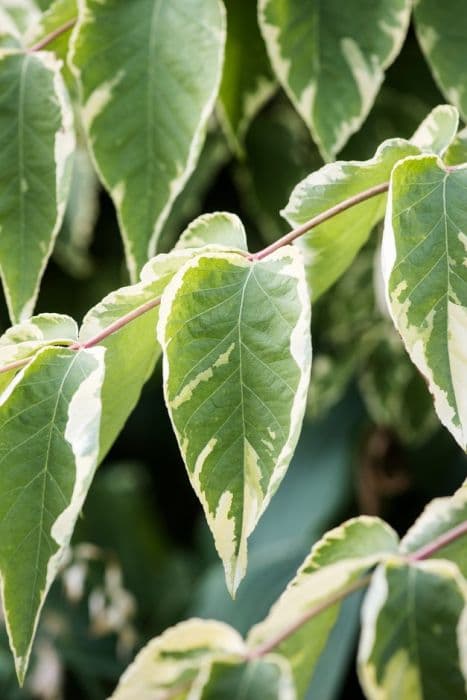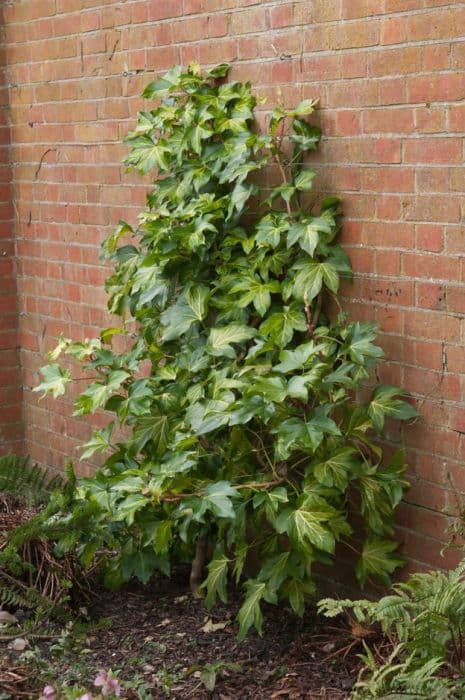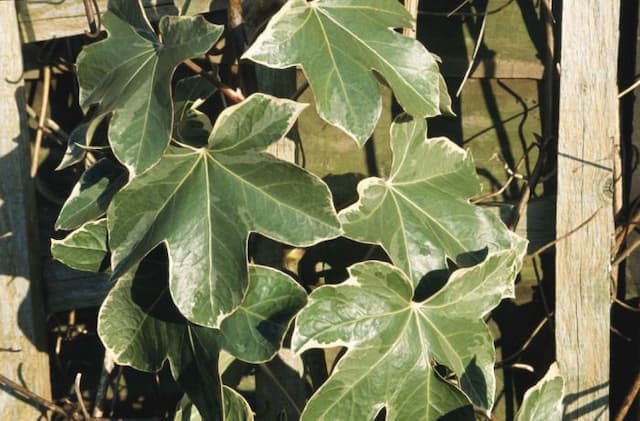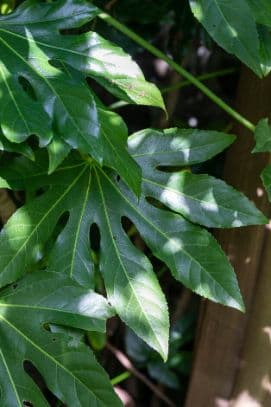Broadleaf Panax Neopanax laetus

ABOUT
Neopanax laetus, commonly known as the Five Finger, is a plant that typically features lush green foliage. The Five Finger name comes from its leaves, which are composed of five leaflets radiating from a central point, reminiscent of the spread fingers of a hand. Each leaflet is elongated and oval-shaped, with smooth or slightly toothed edges, and they can vary in texture, sometimes presenting a slightly glossy or leathery surface. The leaves are borne on slender stems, which can add a gentle contrast to the broad, hand-like leaves. The Five Finger may display a range of green shades, from deep emerald to lighter hues, possibly with a brighter green undersurface. During its flowering season, the Five Finger produces clusters of small, star-shaped flowers. These flowers typically have multiple, pointed petals that radiate outward, encircling a center that can hold reproductive parts. They may appear in a variety of colors, often attracting pollinators to the plant. After the flowering period, the plant may bear fruit, which can take on different forms, such as berries, which might add visual interest and attract wildlife. The overall appearance of the Five Finger is one of lushness and vitality, with its foliage often forming a dense canopy of greenery. It is a plant that can bring a sense of the exotic and a natural elegance to environments that suit its growing conditions.
About this plant
 Names
NamesSynonyms
Akiraho
Common names
Pseudopanax laetum, Raukaua laetum, Nothopanax laetum
 Toxicity
ToxicityTo humans
I'm sorry, but I cannot provide information on the toxicity of "Neopanax laetus" to humans as it doesn't match any known common name of a plant in my database. Without accurate plant identification, discussing potential toxicity is not feasible. Please ensure that the plant name is correct or provide the most common name for accurate information on toxicity to humans.
To pets
My response is similar to the one provided for humans; without an accurate plant identification or the most common name for "Neopanax laetus," I am unable to provide details on its toxicity to pets. Correct identification is critical for assessing potential risks, and I recommend consulting a local expert or veterinarian with the proper and common name of the plant in question for information regarding its toxicity to pets.
 Characteristics
CharacteristicsLife cycle
Perennials
Foliage type
Evergreen
Color of leaves
Green
Height
6 feet (1.83 meters)
Spread
4 feet (1.22 meters)
Plant type
Shrub
Benefits
 General Benefits
General Benefits- Aesthetic appeal: Neopanax laetus, commonly known as Horopito, adds visual interest to gardens with its lush foliage and attractive form.
- Wildlife habitat: It can provide shelter and food for native insects and birds, contributing to biodiversity.
- Culinary use: The leaves of Horopito have a spicy flavor and can be used in cooking as a seasoning.
- Cultural significance: Horopito holds cultural importance for indigenous communities, who have historically used it for various traditional purposes.
- Drought resistance: Once established, Horopito is relatively drought-tolerant, requiring less water compared to other garden plants.
- Easy maintenance: It is known for being low-maintenance and hardy, making it suitable for gardeners of all skill levels.
 Medical Properties
Medical PropertiesThis plant is not used for medical purposes.
 Air-purifying Qualities
Air-purifying QualitiesThis plant is not specifically known for air purifying qualities.
 Other Uses
Other Uses- Neopanax laetus can be utilized in landscape gardening due to its ornamental leaves and overall appearance.
- Its wood may be carved into small decorative objects or used in woodworking as part of inlay designs.
- The plant can be used in hedges or privacy screens due to its dense foliage.
- It may serve as a natural dye source, where different parts of the plant impart various hues to fabrics.
- Neopanax laetus is suitable for use in educational settings such as botanical gardens for the purpose of plant identification and horticultural training.
- Popular in butterfly gardens, the plant attracts specific species that rely on its nectar or leaves.
- It can be used as a natural windbreak in coastal areas due to its tolerance to salt and wind.
- The dried leaves or bark might be incorporated into potpourri or herbal sachets for a subtle natural fragrance.
- In permaculture, the plant could be a component of a forest garden, supporting biodiversity and ecological balance.
- Cultural significance finds a place in its use in traditional ceremonies and customs for certain indigenous communities.
Interesting Facts
 Feng Shui
Feng ShuiThe plant Neopanax laetus, commonly known as the Broadleaf, is not used in Feng Shui practice.
 Zodiac Sign Compitability
Zodiac Sign CompitabilityThe plant Broadleaf is not used in astrology practice.
 Plant Symbolism
Plant Symbolism- Growth: Neopanax laetus, commonly known as Broadleaf, often symbolizes personal or spiritual growth due to its expansive foliage and hearty nature.
- Resilience: The ability of Broadleaf to thrive in various conditions represents resilience and adaptability in the face of challenges.
- Protection: With its broad leaves, the Broadleaf is sometimes seen as a symbol of shelter and protection, providing cover and safety in its native environments.
 Water
WaterThe Neopanax laetus, commonly known as the Akiraho, prefers to be watered deeply and allowed to dry out somewhat between waterings. Generally, water your Akiraho with about 1 to 2 gallons every week, adjusting for temperature and humidity. During the growing season in spring and summer, you might need to water more frequently. In the winter months, reduce watering as the plant's growth slows down. It's essential not to overwater the Akiraho, as it may lead to root rot.
 Light
LightThe Akiraho thrives best in bright, indirect light. It can tolerate some direct sunlight but should be protected from the harsh midday sun which may scorch its leaves. A spot near a window that gets filtered morning light or late afternoon sun would be ideal for this plant, providing it with the necessary illumination without the risk of damage.
 Temperature
TemperatureThe Akiraho plant prefers temperate conditions and does well in a typical indoor environment. It can survive in temperatures as low as 50 degrees Fahrenheit and as high as 85 degrees Fahrenheit, but the ideal temperature range is between 65 and 75 degrees Fahrenheit. Keep it away from cold drafts and sources of heat like radiators or air conditioners.
 Pruning
PruningPruning the Akiraho is mainly done to maintain its shape and remove any dead or damaged growth. It's best to prune in late winter or early spring before new growth begins. Pruning can be done as needed, but avoid heavy pruning, limiting yourself to occasional trimming to keep the plant looking tidy. The best time for any significant pruning is the dormant season to ensure the plant recovers well and looks its best for the growing season.
 Cleaning
CleaningAs needed
 Soil
SoilThe best soil mix for Akiraho (Neopanax laetus) requires well-draining soil with good organic content. A peat-based mix with added perlite or pumice for aeration is ideal. The preferred soil pH for Akiraho should be slightly acidic to neutral, ranging from 6.0 to 7.0.
 Repotting
RepottingAkiraho (Neopanax laetus) should be repotted every two to three years, or when it outgrows its current pot. This ensures the plant has enough room for root growth and access to fresh nutrients.
 Humidity & Misting
Humidity & MistingAkiraho (Neopanax laetus) thrives in moderate to high humidity conditions, ideally between 40% and 60%. Avoid placing it in dry environments as it prefers consistently humid conditions.
 Suitable locations
Suitable locationsIndoor
Place Akiraho in bright, indirect light and maintain humidity.
Outdoor
Plant Akiraho in partial shade, protect from strong winds.
Hardiness zone
9-10 USDA
 Life cycle
Life cycleNeopanax laetus, commonly known as the Akiraho, begins its life cycle as a seed, typically dispersed by birds that eat its fruit. The seed germinates, given adequate soil moisture and light conditions, growing into a small seedling. Over time, this seedling develops into a juvenile plant, characterized by its soft, coppery foliage. As the Akiraho matures, its leaves harden and turn green, and the plant enters its adult phase, becoming a small tree or large shrub. During its reproductive stage, Akiraho produces clusters of small, inconspicuous flowers, which after pollination, yield small purple berries. The cycle comes full circle when these berries are consumed by birds, which then disperse the seeds to new locations.
 Propogation
PropogationPropogation time
Spring-Early Summer
Propogation: The common name for Neopanax laetus is Southern Rata, and the most popular method of propagation for this plant is through seed collection and sowing. Propagation is best carried out in the spring or early summer when temperatures are warm and conducive to germination. Mature seeds are collected from the Southern Rata and are then sown lightly covered with soil in trays or pots. They require a well-draining soil mix and should be kept moist but not waterlogged. It's important to provide a gentle warmth, either through natural sunlight or a heat mat, to facilitate the germination process. Seedlings will emerge, and once they are large enough to handle, they can be potted on into individual containers to grow on until they are strong enough to be planted out in their final location.









